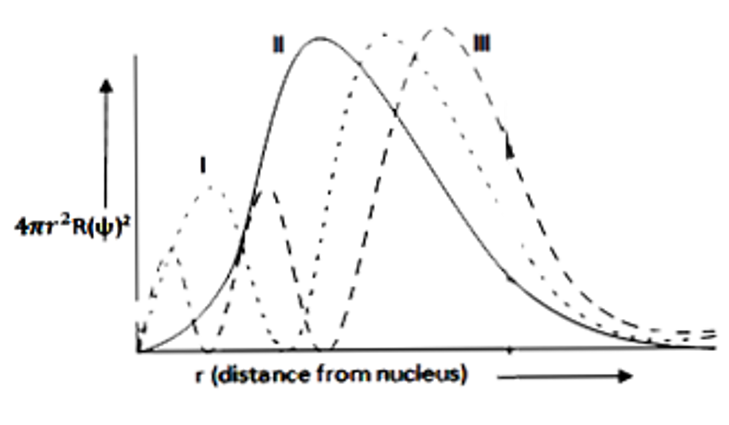The radial distribution curve of 2s sub-level consists of x nodes. Value of x is :
The correct Answer is:1
To determine the number of nodes in the radial distribution curve of the 2s sub-level, we can follow these steps:
1. Understand the Definitions:
- Nodes are points where the probability density of finding an electron is zero. There are two types of nodes: angular nodes and radial nodes.
- The total number of nodes in an atomic orbital is given by the formula:
Total Nodes=n−1
- The number of angular nodes is given by L.
- The number of radial nodes is given by:
Radial Nodes=n−1−L
2. Identify Quantum Numbers for 2s:
- For the 2s sub-level:
- The principal quantum number n=2.
- The azimuthal quantum number L=0 (since 's' orbitals have L=0).
3. Calculate Total Nodes:
- Using the formula for total nodes:
Total Nodes=n−1=2−1=1
4. Calculate Angular Nodes:
- Since L=0:
Angular Nodes=L=0
5. Calculate Radial Nodes:
- Using the formula for radial nodes:
Radial Nodes=n−1−L=2−1−0=1
6. Conclusion:
- The number of radial nodes for the 2s sub-level is 1. Therefore, the value of x is:
x=1
Final Answer:
The value of x is 1.
---
- Nodes are points where the probability density of finding an electron is zero. There are two types of nodes: angular nodes and radial nodes.
- The total number of nodes in an atomic orbital is given by the formula:
Total Nodes=n−1
- The number of angular nodes is given by L.
- The number of radial nodes is given by:
Radial Nodes=n−1−L
- For the 2s sub-level:
- The principal quantum number n=2.
- The azimuthal quantum number L=0 (since 's' orbitals have L=0).
- Using the formula for total nodes:
Total Nodes=n−1=2−1=1
- Since L=0:
Angular Nodes=L=0
- Using the formula for radial nodes:
Radial Nodes=n−1−L=2−1−0=1
- The number of radial nodes for the 2s sub-level is 1. Therefore, the value of x is:
x=1
The value of x is 1.
Topper's Solved these Questions
- BOOK - RESONANCE ENGLISHCHAPTER - NUCLEAR CHEMISTRYEXERCISE - PART -III :8videos
NUCLEAR CHEMISTRY
- BOOK - RESONANCE ENGLISHCHAPTER - NUCLEAR CHEMISTRYEXERCISE - PART-IV : COMPREHENSION13videos
NUCLEAR CHEMISTRY
- BOOK - RESONANCE ENGLISHCHAPTER - NUCLEAR CHEMISTRYEXERCISE - Exercise-291videos
NUCLEAR CHEMISTRY
- BOOK - RESONANCE ENGLISHCHAPTER - NITROGEN CONTAINING COMPOUNDSEXERCISE - ORGANIC CHEMISTRY(Nitrogen containing Compounds)30videos
NITROGEN CONTAINING COMPOUNDS
- BOOK - RESONANCE ENGLISHCHAPTER - P BLOCK ELEMENTSEXERCISE - PART -II23videos
P BLOCK ELEMENTS
Similar Questions
If the median of the distribution given below is 28.5 , find the values of x and y.
 View Solution
View SolutionThe probability distribution of a discrete random variable X is given below

The value of k isView SolutionThe probability distribution of a discrete random variable x is given as under

Calculate
(i) the value of A, if E(X)=2.94.
(ii) variance of X.View SolutionThe probability distribution of a discreate random variable X is given below :

The value of k isView SolutionThe following is the probability distribution of a random vaiable X.
The value of k is
 View Solution
View SolutionThe number of nodes possible in radial probability distribution curve of 3d orbital is
View SolutionIf A = {x : x is a multiple of 4} and B = {x : x is a multiple of 6}, then A ⊂ B consists of all multiple of (A) 4 (B)8 (C) 12 (D)16
View SolutionConsider the following radial distribution function diagrams. Which of the following has the correct matching of curve and orbital?
 View Solution
View SolutionA discrete random variable X has the probability distribution given below: X:0.511.52 P(X):kk22k2k Find the value of k. (ii) Determine the mean of the distribution.
View SolutionFor the function f(x)=1+3xln3 find the antiderivative F(x), which assumes the value 7 for x=2. At what values of x does the curve F(x) cut the x-axis?
View Solution

